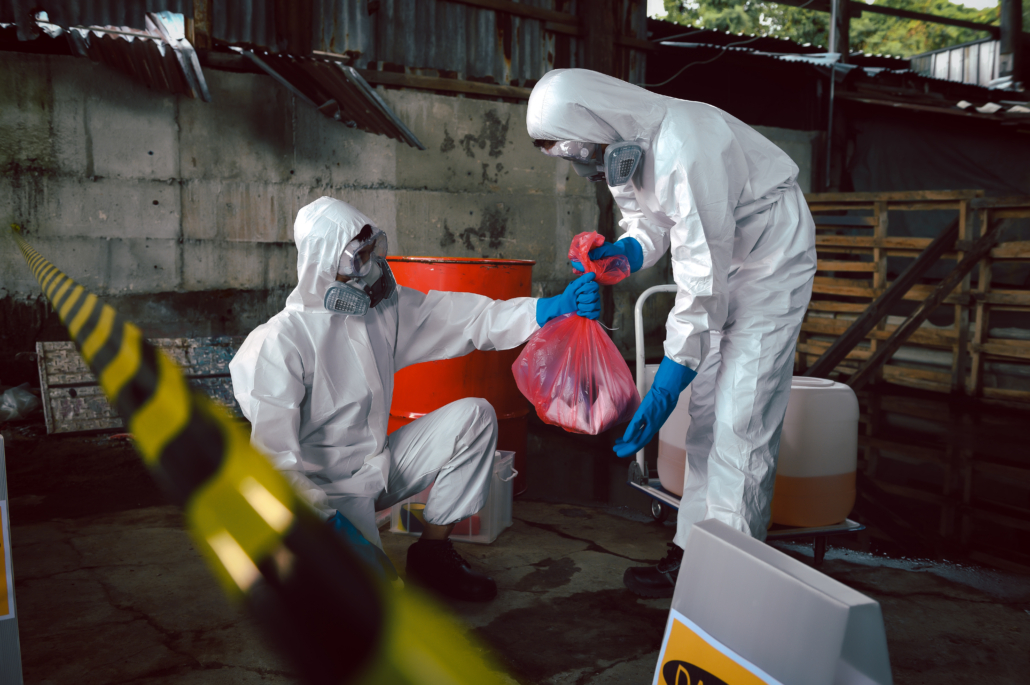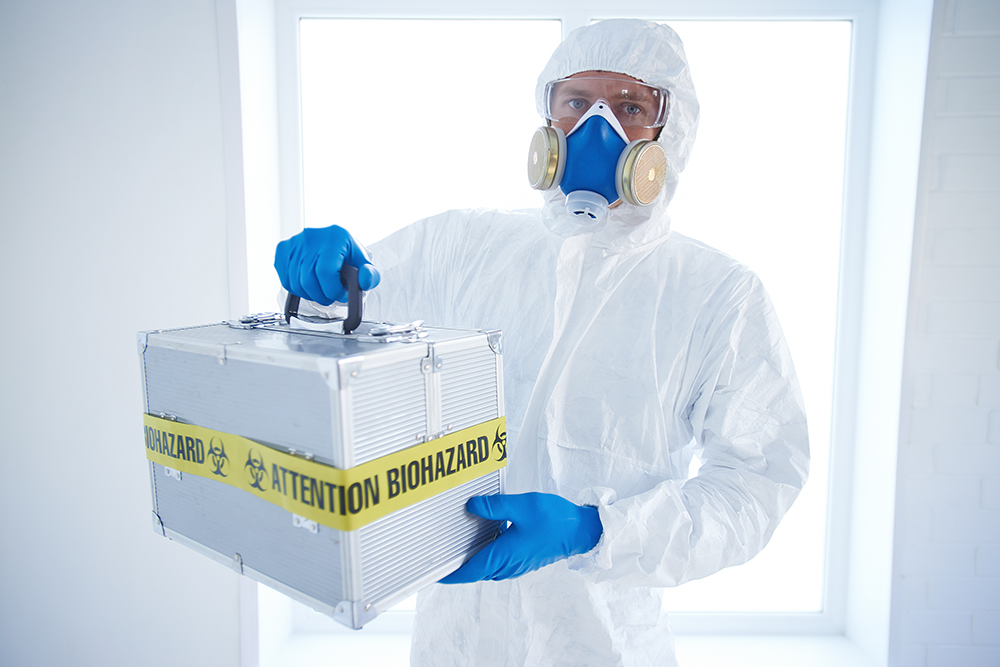Clandestine Lab Cleanup: Comprehensive Purification for Hazardous Sites
Clandestine Lab Cleanup: Comprehensive Purification for Hazardous Sites
Blog Article
Expert Biohazard Cleanup for Crime Scenes, Trauma Incidents, and Infected Rooms
In the world of professional biohazard cleanup, thorough interest to detail and adherence to safety protocols are critical. As we dig into the ins and outs of biohazard clean-up for these delicate settings, a deeper understanding of the difficulties and essential procedures entailed will certainly arise, shedding light on the vital duty of expert cleaning services in recovering security and tranquility of mind.

Significance of Biohazard Clean-up
Biohazard clean-up adhering to criminal activity scenes and trauma incidents is crucial for making sure the security of people and the setting. When these incidents take place, they typically leave behind a range of biohazards such as blood, bodily liquids, and various other possibly infectious materials. These substances can harbor hazardous pathogens like bacteria and infections, posturing severe health and wellness risks otherwise effectively cleansed and sterilized.
Expert biohazard cleaning solutions are educated to handle these harmful materials safely and successfully. They have the needed equipment, such as individual safety equipment and specialized cleaning up representatives, to thoroughly sanitize the impacted locations. By turning over the cleanup to experienced experts, people can prevent exposure to dangerous virus and avoid the spread of contagious diseases.
In addition, correct biohazard cleaning is important for safeguarding the setting. Improper disposal of biohazardous materials can infect soil, water resources, and air, positioning a danger to wild animals and the environment. By following stringent cleanup methods, experts can ensure that biohazards are securely removed and gotten rid of in conformity with regulations, reducing the danger of environmental contamination.
Types of Biohazards Encountered
Various unsafe materials typically come across in crime scenes and trauma incidents existing substantial wellness risks if not handled effectively. Blood and physical liquids are among the most usual biohazards discovered in these situations.
Another sort of biohazard typically experienced is sharp items like needles, damaged glass, and other things that can create injuries and transmit infections. Chemical hazards are also a problem, as criminal offense scenes may consist of materials like tear gas, pepper spray, or medication manufacturing products that require specific handling and disposal procedures to avoid additional damage.
Moreover, mold and bacteria development can take place in areas where decomposition or extended direct exposure to wetness has occurred. These microorganisms can launch contaminants and allergens right into the air, posturing breathing risks to those exposed. In general, biohazard cleaning experts must be skilled and well-equipped to properly handle these various sorts of hazardous materials to make sure the safety and security of themselves and others.
Tools and Protective Equipment
When resolving the critical task of handling biohazards encountered in crime scenes and injury incidents, the use of appropriate tools and protective gear is extremely important to making certain the safety of individuals involved in the cleanup process. Personal safety tools (PPE) such as gloves, safety glasses, coveralls, and masks are necessary to prevent direct call with possibly hazardous compounds. Respirators are critical when dealing with biohazards that may come to be airborne, protecting workers from breathing in harmful bits. Specialized cleansing tools like biohazard sharps, anti-bacterials, and bags containers are needed for the safe collection and disposal of infected materials. In addition, heavy-duty devices such as industrial-grade cleaner, foggers, and ozone generators might be needed to completely sanitize the afflicted area. Making sure that all devices is properly maintained, on a regular basis checked, and utilized according to security guidelines is essential in decreasing the risk of direct exposure to biohazards during clean-up operations.
Cleaning Process and Strategies
Reliable and detailed cleaning of biohazardous products from criminal activity scenes and trauma events requires thorough focus to information and adherence to how to clean up blood from tile stringent safety procedures. The clean-up process normally involves numerous essential actions.
Following the removal of biohazardous products, the afflicted location goes through a detailed cleansing and disinfection procedure. This action entails using specialized cleaning agents and tools to make sure that all traces of contamination are eradicated. After cleansing, the area goes through rigorous screening to verify that it is cost-free and risk-free of any staying biohazards.

Decontamination and Disposal Treatments
To guarantee detailed decontamination and appropriate disposal of biohazardous materials, complying with the careful clean-up procedure, certain procedures need to be thoroughly adhered to with stringent adherence to safety methods. Purification involves the removal or neutralization of impurities to decrease the threat of direct exposure and spread of unsafe substances. This process normally consists of cleansing, disinfecting, and sanitizing the damaged location using specific equipment and EPA-approved chemicals.
When purification is completed, correct disposal of biohazardous materials is essential to avoid further contamination or damage. Biohazardous waste, such as physical fluids or blood-soaked materials, need to be carefully collected, packaged, and classified according to governing guidelines. ATP testing. These materials are then delivered to qualified centers for disposal through ideal channels, ensuring compliance with local, state, and government guidelines

Conclusion
Finally, specialist biohazard cleaning is essential for ensuring the safe and reliable removal of hazardous materials from crime scenes, injury cases, and contaminated areas. By using specialized tools, protective gear, and following appropriate cleaning procedures and techniques, biohazard clean-up groups can efficiently get rid of and sanitize of biohazards, lessening the risk of exposure and damage to individuals and the atmosphere.
As we dive into the details of biohazard cleaning for these delicate atmospheres, a much deeper understanding biohazard cleanup estimate of the difficulties and essential procedures included will certainly emerge, shedding light on the important duty of professional cleaning solutions in bring back safety and security and peace of mind.
Specialist biohazard clean-up solutions are educated to manage these harmful materials securely and effectively. By following rigorous clean-up methods, experts can make certain that biohazards are safely eliminated and disposed of in accordance with guidelines, reducing the threat of ecological contamination.
Generally, biohazard cleanup experts need to be fully equipped and experienced to properly deal with these various types of unsafe materials to ensure the security of themselves and others.
When attending to the vital task of dealing with biohazards come across in criminal offense scenes and injury occurrences, the use of proper devices and protective equipment is critical to ensuring the safety and security of individuals involved in the cleanup procedure.
Report this page